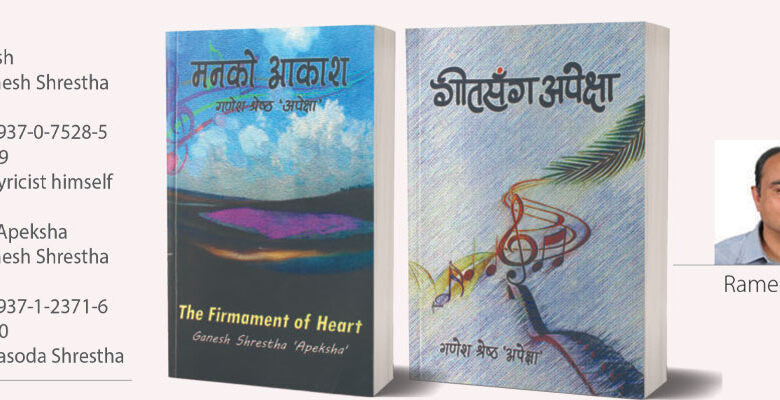Two Poetic Anthologies Of Lyricist ‘Apeksha’

“Keep always smiling in places where my eyes set upon Keep me safe with you, and in your memories forlorn”
These beautiful lines have been taken from Manko Akash (2020), the first anthology of lyricist Ganesh Shrestha’s ‘Apeksha.’
Ganesh, having been born in Sankhuwasabha, Khandbari-5, Malta, is a known name among music lovers. His lyrics have been published repeatedly in Madhuparka, Gorkhapatra, Muna, Yuba Mancha, and many other publications, so he is equally popular among readers. After vocalist Yam Baral published a song based on his lyrics with music by Bulu Mukarung for the first time, many of his lyrics have been converted into audio by prominent music producers.
I have been gifted two lyric collections, Manko Akash (2020) and Geetsang Apeksha (2022), by lyricist Ganesh. The anthologies let me know that his lyrical journey had begun after he dropped by Kathmandu for higher study.
I enjoy, appreciate and also learn from the exemplary works of others in my related field, so this time too, I am grasping this opportunity to express my findings from Ganesh’s anthologies.
Although Ganesh is living in the USA, his activities are noteworthy for the Nepali music industry’s enrichment. He has published two music albums, Bato Hinda (2020) and Raharka Phoolharoo (2022), two lyrical collections, and has contributed to a musical career of many talents. The first lyrical collection by him is Manko Akash, and the second is Geetsanga Apeksha. The collection Geetsanga Apeksha has 112 pages, while Manko Akash contains 129 pages. Geeksanga Apeksha has 79 individual lyrics.
Manko Akash includes 55 separate lyrics, which have also been translated into English. Popular lyricists Pramod Dhungana and Gyanendra Gadal have written prefaces to Geetsanga Apeksha. While Prof. Dr. Krishna Hari Baral and popular poet/lyricist Shrawan Mukarung have granted prefaces to Manko Akash. Creator Ramesh Poudel has designed the covers. Expert songwriters have concluded that both anthologies have been crafted by applying the contemporary principles of Nepali songwriting and ethics.
Ganesh enhanced his theoretical knowledge of crafting lyrics through his academic work for the master’s degree, which has helped him craft lyrics following already established doctrines. His writings are lyrically rigorous and panoramic.
Some of the lyrics contained in the anthologies are electronically available, while others are saved in music albums. The lyrics in both anthologies have either been presented to readers in the form of a poem or a song, while many of them are waiting for melody and vocals.
Writing lyrics, the oldest and most popular form of literature, is a kind of uncommon subjective poetry because it means playing with words to satisfy the demands of a musical tune. A poet may not create perfect lyrics for perfect melody, but a lyricist must do that with the responsibility of conveying a complete message to the audience using possibly the fewest words. A lyricist widely uses self-expression to describe his or her endeavours within a few consistent lines. Many lyrics as Ganesh expresses their feelings about both the inner and outer worlds through lyrics. Ganesh is creating lyrics with proper blending of the intro and verse lines of the lyrics in slime size.
A “lyric” was once used to describe a poem sung with a specific musical instrument, the lyre. Today, the word ‘lyrics’ is commonly used to refer to a poem that is fit for a musical tune. A poem is a lyric that expresses personal feelings in rhythmic form.
A lyricist must follow the grammar of lyrics. However, it depends on his or her skills to manoeuvre it. According to Prof. Dr. Baral, simplicity is one of the major characteristics of a lyric, so that it can easily touch the audience. Also, lyricist Rajendra
Thapa and others believe that lyrics must have a single emotion and fit a specific musical quality. Many expert lyricists believe that a song’s lyrics should be symbolic, and they should own them. Here, Ganesh proves himself to have perfect lyricism by maintaining the general principles of a perfect lyric.
“Ocean of tears, I have trickled in your memory today
No one in the world is a treacherous as you portray”
(Manko Akash, page 65)
We are proud of our culture and natural beauty. We have diversity in language, food, festivals, dress, and accent. Nepali songwriting is not possible if a lyricist misses the Nepali context. Lyricist Ganesh has widely used themes from cultural practises in his lyrical works. So, his lyrics are lively and based on the truth, although some of them are imaginary.
Ganesh crafts songs based on Nepali modern, patriotic, folk-based, and children’s songs. His lyrics, written identically in lyrical structure, have portrayed stories of love and affairs, patriotism, humanity, and life hardship. The lyrics in both anthologies exhibit different dimensions of human behaviour. His lyrics focus repeatedly on love and affairs. He seems smart for expressing human sentiment in his lyrics. I found that his lyrics convey the message of ‘Do No Harm’. So, one can turn herself or himself into a positive person after listening to his creations. Being a migrant creator, his lyrics demonstrate the grief of missing his homeland, culture and life patterns.
It is natural that most of his lyrics are themed on love and tragedy, but this is not always true for him. His anthologies have capitalised on themes far from boundaries, touching human sensitivity and requirements. The following lyrics by him intend to connect people with brotherhood and sisterhood.
“Yati Sundar Sansarbhari Mahan Shrishti Manchhe Hami
Ajhai Sundar Banchha Sansar, Mile Sabai Manchhe Hami”
(Geetsanga Apeksha, page 76)
Despite the fact that Ganesh tries to create error-free creations, it is not possible for him or anyone else, but unknowingly made errors are taken as a part of art as they add new style to creations. So, there is no logic for a creator like Ganesh to be disappointed in unknowingly made errors. But self-realisation of his own errors will refine his upcoming creations.
Lyricist Pramod Dhungana suggests that Ganesh should care about the length of the lyrics, which is a critical grammar for perfect lyricism. It would add value if Ganesh cared about the consistency in each line for an easy melody catch-up. Ganesh accepts that the guidance from Prof. Dr. Baral, lyricist Buddhabir Lama, and lyricist/poet Shrawan Mukarung and his self-exploration have refined his lyrical works. While reading his anthologies, one can conclude that his lyrical works promptly follow the songwriting legacy of these experts.
I found that Ganesh made efforts to craft error-free lyrics, but experts may suggest that he care about grammar. Experts praise him for the fact that the inclusion of lyrics from modern, patriotic, child-focused, and folk-based Nepali songs allows the reader to enjoy them in a single anthology. However, I expect he will accept that no one can enhance expertise in multiple areas at a time. While going through the lyrics, I would like to take the opportunity to suggest that he think about structural diversity in his creations.
For example, in both anthologies, most of the lyrics are crafted in ten lines, almost the same length, which is our traditional way of writing—and that is not bad either. But a creative lyricist tries to break the ways of traditional songwriting by extending his or her creativity. Although Ganesh’s lyrical theme selection covers a wide spectrum, structural diversity will add additional beauty to his writing.
(Reviewer is a lyricist and researcher)




